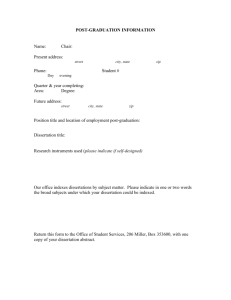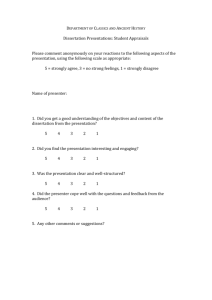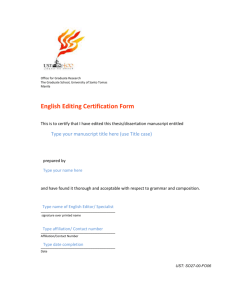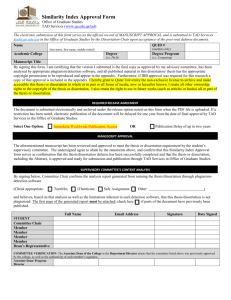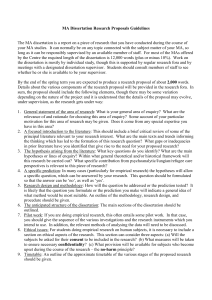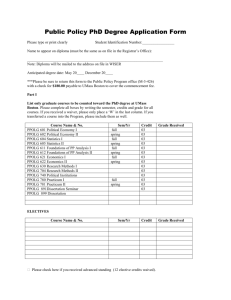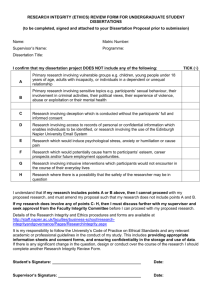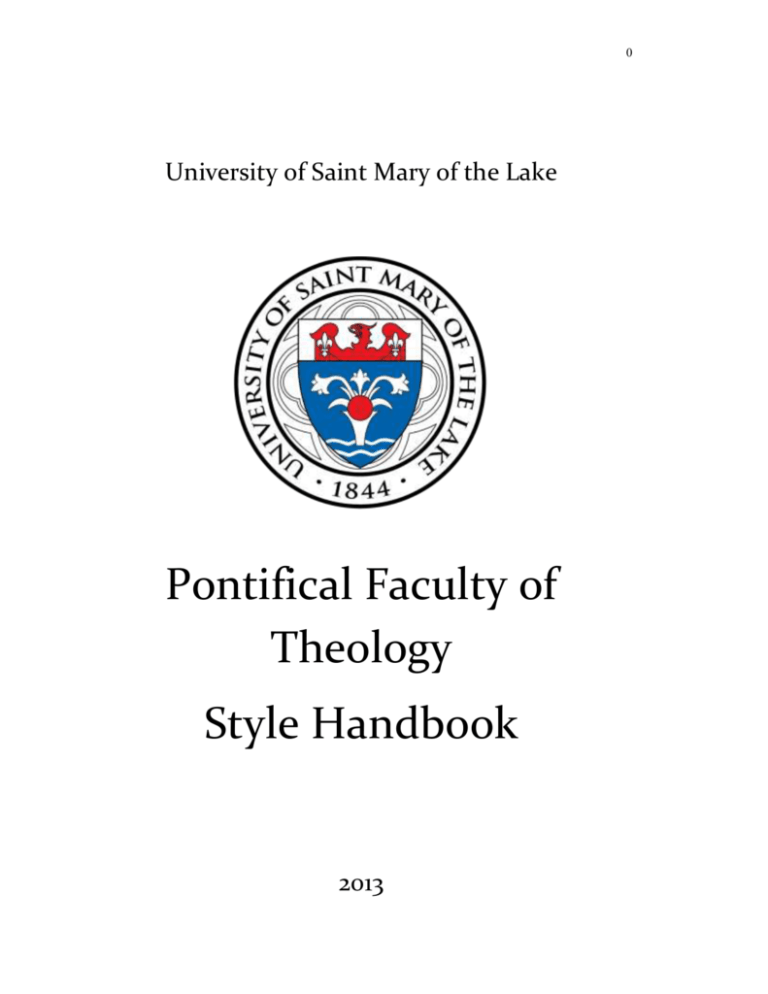
0
University of Saint Mary of the Lake
Pontifical Faculty of
Theology
Style Handbook
2013
0
© 2013 University of Saint Mary of the Lake
All rights reserved
i
CONTENTS
INTRODUCTION .............................................................................................................. 1
I
BACCALAUREATE OF SACRED THEOLOGY (S.T.B.) ...................................... 1
RESEARCH PAPER .......................................................................................................... 1
II
LICENTIATE OF SACRED THEOLOGY (S.T.L) THESIS .................................... 1
A.
WRITING YOUR THESIS .................................................................................... 2
Resources .................................................................................................................... 2
Style ............................................................................................................................ 2
The Writing Center ..................................................................................................... 3
Copyright .................................................................................................................... 3
B.
THE ELEMENTS OF YOUR THESIS .................................................................. 3
Preliminary Pages ....................................................................................................... 3
Title Page ................................................................................................................ 3
Copyright Notice (optional) .................................................................................... 3
Certification (Signature) Page ................................................................................ 3
Optional Preliminary Pages ................................................................................... 4
Table of Contents .................................................................................................... 4
Body of Text ............................................................................................................... 4
Text .......................................................................................................................... 4
Introduction (optional)............................................................................................ 4
Chapters .................................................................................................................. 5
Footnotes................................................................................................................. 5
Illustrative Materials .............................................................................................. 5
End Matter .............................................................................................................. 6
Bibliography ........................................................................................................... 6
ii
B.
PREPARING YOUR MANUSCRIPT ................................................................... 6
Word Processing ......................................................................................................... 6
Font ............................................................................................................................. 7
Formatting Paragraphs ................................................................................................ 7
Printer.......................................................................................................................... 7
Paper ........................................................................................................................... 7
Page Alignment ........................................................................................................... 7
Margins ....................................................................................................................... 7
Line Spacing ............................................................................................................... 8
Page Numbering.......................................................................................................... 8
Page Number Placement ............................................................................................. 8
Page Number Placement Guide .................................................................................. 9
C.
SUBMITTING THE FINAL MANUSCRIPT...................................................... 10
Submitting the Thesis to the Registrar ...................................................................... 10
D.
ADDITIONAL INFORMATION ......................................................................... 10
E.
S.T.L. Thesis Sample Pages .................................................................................. 11
S.T.L. TITLE PAGE ................................................................................................. 12
COPYRIGHT PAGE (optional) ............................................................................... 13
S.T.L. CERTIFICATION PAGE .............................................................................. 14
DEDICATION PAGE (optional) .............................................................................. 15
EPIGRAPH PAGE (optional) ................................................................................... 16
PREFACE (optional) ................................................................................................ 17
III
DOCTOR OF SACRED THEOLOGY (S.T.D) DISSERTATION.......................... 18
A.
THE DISSERTATION PROPOSAL.................................................................... 18
The Literature Review .............................................................................................. 19
iii
The Claim.................................................................................................................. 19
The Proposal Outline ................................................................................................ 19
B.
DOCTORAL COLLOQUIUM ............................................................................. 20
C.
WRITING YOUR DISSERTATION ................................................................... 20
Copyright .................................................................................................................. 21
D.
THE ELEMENTS OF YOUR DISSERTATION ................................................. 21
Title Page .................................................................................................................. 21
Abstract Page ............................................................................................................ 21
Certification (Signature) Page................................................................................... 22
Imprimatur Page........................................................................................................ 22
E.
PREPARING YOUR MANUSCRIPT ................................................................. 22
F.
SUBMITTING THE FINAL MANUSCRIPT...................................................... 22
Manuscript Review ................................................................................................... 22
Submitting the Dissertation for Publication by ProQuest ......................................... 23
Submitting the Dissertation to the Registrar ............................................................. 23
Personal Bound Copies of the Dissertation .............................................................. 24
Publishing Your Dissertation With Another Publisher ............................................. 24
G.
DISSERTATION CHECKLIST ........................................................................... 25
H.
Additional Information ......................................................................................... 25
I.
S.T.D Dissertation Sample Pages ......................................................................... 26
S.T.D DISSERTATION TITLE PAGE .................................................................... 27
S.T.D. DISSERTATION TITLE PAGE—LITURGICAL INSTITUTE ................. 28
S.T.D.DISSERTATION ABSTRACT ..................................................................... 29
COPYRIGHT PAGE (optional) ............................................................................... 30
S.T.D. CERTIFICATION PAGE ............................................................................. 31
iv
S.T.D. DISSERTATION IMPRIMATUR PAGE .................................................... 32
1
INTRODUCTION
This handbook is written for you, a student in the process of writing a research paper
for an S.T.B. course, a thesis for the S.T.L. degree, or a dissertation in partial fulfillment
of the requirements for the Doctor of Sacred Theology degree, from The University of
Saint Mary of the Lake. It is the official guide to university requirements governing the
preparation and submission of your papers.1
Your paper is an important document, both academically and for you personally. For
this reason we expect you to exercise the utmost care in the preparation of the final
manuscript, as an expression of the quality of your scholarship and the value of your
achievement.
I
BACCALAUREATE OF SACRED THEOLOGY (S.T.B.)
RESEARCH PAPER
The Bulletin of the Pontifical Faculty of Theology stipulates that three of the
required courses from the M.Div. schedule of courses (9 hours) need to be dedicated to
the S.T.B., which means that in addition to the coursework required for each of these
courses, the student will write a 15-20 page research paper.
During the process of writing and submitting these papers, you should consult the
USML Writer’s Style Manual for guidance on preparing the manuscript, and formatting
the text, footnotes, and bibliography.
II
LICENTIATE OF SACRED THEOLOGY (S.T.L) THESIS
All USML S.T.L and candidates are required to:
1.
submit two copies of the final, approved thesis to the Registrar in the
Office of the Academic Dean; and
2.
submit an electronic version of the thesis in PDF format to the Library.
Your thesis is an important university document, both academically and for you
personally. In order to assure that thesis manuscripts from The University of Saint Mary
of the Lake reflect the importance we place on them, we require that you follow these
formatting and submission guidelines. Since you are personally and ultimately
responsible for following the guidelines and instructions in this handbook, you are
required to read it completely and carefully. We encourage faculty and staff to
The “Introduction” and some of the content of the handbook have been adapted from the
Catholic University of America Doctoral Dissertation Handbook, accessed December 3, 2010,
http://graduatestudies.cua.edu/res/docs/Doctoral-Dissertation-Handbook-rev-2009.pdf.
1
2
familiarize themselves with the contents of the handbook, since they are often asked to
advise students in the preparation of the manuscripts.
With the development of new technologies and revised university policies, the
guidelines for the preparation and submission of manuscripts may change from year to
year. We therefore advise against referring to previous editions of the handbook, or using
a previously submitted and published manuscript as a guide for format or layout. If your
research extends over several years, we also ask that you request a current version of the
handbook from the Office of the Academic Dean or access a current version on the Web
at http://www.usml.edu prior to preparing your final manuscript.
A. WRITING YOUR THESIS
Resources
Expectations for the S.T.L. thesis are detailed in the University of Saint Mary of
the Lake Bulletin of the Pontifical Faculty of Theology. You are expected to meet the
requirements detailed in the most recent edition of the appropriate bulletin.
In addition, it’s recommended that you obtain a copy of the most recent edition of
The Craft of Research, by Wayne C. Booth, et al. (Chicago: University of Chicago
Press), to guide research, thesis development, and composition of the thesis. Copies are
available in the Library and in the Regina Cleri Bookstore.
Style
Follow instructions in this handbook for formatting pages, title pages, and front
matter.
Follow instructions in the USML Writer’s Style Manual
http://www.usml.edu/library/writing-help for formatting citations, footnotes, and
bibliography entries.
Use Kate L. Turabian, A Manual for Writers of Term Papers, Theses, and
Dissertations (Chicago: University of Chicago Press, most recent edition) [hereafter
referred to as Turabian] for guidance in areas that are not covered by this handbook
and the Writer’s Style Manual. You should purchase a copy of Turabian to have on
hand as you write and format your thesis.
Consult The Chicago Manual of Style (Chicago: University of Chicago Press, most
recent edition) [hereafter The Chicago Manual] for all situations that are not covered
by this handbook, the Writer’s Style Manual, or Turabian.
These reference works are available in the Library and are usually available at the
Regina Cleri Bookstore and many other bookstores.
3
The Writing Center
The USML Writing Center http://www.usml.edu/library/writing-help , located in the
Feehan Memorial Library, provides support services to students at all stages of the
writing process, from research through final submission.
Make an appointment via e-mail to lolley@usml.edu , or call 847-970-4833.
Copyright
As author, you have copyright privileges immediately upon creation of your
thesis, whether or not you register your copyright with the U.S. Copyright Office in the
Library of Congress. If you choose to register your copyright you may do so directly with
the Library of Congress Copyright Office http://www.copyright.gov/ .
B. THE ELEMENTS OF YOUR THESIS
Preliminary Pages
See the Page Number Placement Guide below for the order and numbering of all
pages.
Title Page
The title page must follow exactly the formatting examples given in the S.T.D sample
pages (Chapter II.E.).
Use word substitutes for formulas, symbols, superscripts, Greek letter, or other
nonalphabetical symbols in the title.
You must use your “name of record” on the title page. This is your official name, as
recorded by the USML Registrar. If this name uses titles or suffixes, include them.
However, you may not include job titles or organizational affiliations (your diocese,
your employer, etc.).
The date on the title page of your thesis is the month and year in which you graduate.
Copyright Notice (optional)
If you choose to include a copyright notice, follow the sample page.
Certification (Signature) Page
Prepare the certification page, following the sample page in Chapter II.E. below.
Print the page out on the same acid-free paper required for submission of your
manuscript, and take it with you to your oral defense.
Your dissertation must have a certification page signed by your thesis director and
the President of the Pontifical Faculty. You are responsible for typing this page and
obtaining the necessary signatures. Manuscripts that do not include a signed approval
page may not be accepted for deposit. Signature substitutions are unacceptable
4
Optional Preliminary Pages
Your thesis director may permit you to include additional pages, such as a
dedication, an epigraph, a list of illustrations, and a preface, in the front matter of your
thesis.
A dedication acknowledges someone who has been especially important to you.
An epigraph is a quotation that establishes the theme of the paper.
If you have illustrations and/or tables, list them separately from the Table of
Contents. Consult Turabian, “Appendix: Paper Format and Submission,” for
formatting instructions.
In a preface, you explain what motivated your study. You may also include
acknowledgements, by which you thank mentors and colleagues that supported your
research.
Consult Turabian, “Appendix: Paper Format and Submission,” for formatting
instructions for these and other optional front matter, such as the glossary, or abbreviation
list. Refer to the Pagination section of this handbook for information on the order of
appearance and pagination of these optional preliminaries.
Table of Contents
Label the first page of the table of contents as Contents.
List in order the chapters or other units of text, and then the elements of back matter
(appendices, bibliography, etc.).
Do not include the pages that precede the table of contents (title page, copyright page,
abstract, etc.).
Use the same numbering (arabic or lower-case roman) that appears on the pages
themselves.
List page numbers along the right margin.
Body of Text
Consult Turabian, “Appendix: Paper Format and Submission” for sample pages
of the elements listed below.
Text
See the Formatting Your Manuscript section for information on preparing the text.
Begin to use arabic numerals for page numbering with the first page of the text.
Center the text of the label (e.g., Introduction, Chapter 3) on the first page of the
section.
Introduction (optional)
The introduction is the equivalent of a first chapter the thesis, not part of the
preliminary materials.
Label the first page of the introduction as Introduction.
5
Chapters
Begin each chapter (or part/chapter combination) on a new page.
Label each first chapter page as Chapter, followed by the arabic numeral (4) or
spelled-out number (Four). If the first chapter page is the first page of a part, you
may combine the information in one label, e.g., Part V: Chapter 1.
If the chapter has a title, enter a blank line between the Chapter label and then enter
the title.
Enter two blank lines between the Chapter label (or the title, if used) and the first line
of text.
Footnotes
You must record your citations as footnotes; endnotes are not acceptable.
Number footnotes consecutively throughout the entire paper.
If you have more than 100 footnotes, number them consecutively by chapter. That is,
the first footnote of each chapter should be numbered “1.” (If you are using Microsoft
Word, divide the chapters using the “section break” feature in Page Layout; then reset
the first footnote to “1” for each section.)
Refer to the USML Writer’s Style Manual or Turabian for notation and reference
format.
Use a smaller font for notes than you use for the text.
Illustrative Materials
Illustrative materials include photographs, charts, graphs and tables, prints, maps,
reproductions, renderings, hand-drawn items, etc. These may be black-and-white or
color. You will rarely incorporate these into a thesis, but if there is need for illustrations
follow these guidelines
You may create color tables, graphs, maps, and other illustrative material.
If you are incorporating illustrations, e.g., photographs, line drawings, from other
sources, scan the illustrations at a minimum of 600 dpi and insert them as objects in
your manuscript at the appropriate place.
You may include illustrative materials either in the body of the text or in the
appendix.
If you include illustrations in the text, insert the items as close as possible following
their first reference in the text.
If you include the illustrations in an appendix, precede each item with an explanation.
Charts may be in color in the original manuscript, but make sure that they are
understandable when reproduced in black and white.
The ink used to print a color item must be permanent and stable, retain its brilliance,
and not flake or brush off with age.
If possible, reduce the over-sized items to 8.5 inches x 11 inches page size.
6
If you must include special symbols or other hand-drawn elements in the text or as
illustrative materials, use only high-quality waterproof black ink and render the handdrawn elements as carefully, clearly, and neatly as possible.
End Matter
Every thesis has a bibliography, but there may be other optional end matter, such
as an appendix or appendices, a glossary, a list of abbreviations (the glossary and
abbreviations list may also appear with the preliminary pages) and addenda (nontext
items such as tapes, CDs, etc.). Consult Turabian, “Appendix: Paper Format and
Submission” for examples of many of the elements listed below.
Letters of Permission
o If you use material that does not fall in the “fair use” category, you must
request permission from the holder of the copyright to include the materials in
your thesis.
o For information on “fair use” and an example of a letter requesting permission
to use the material, see the Library Director.
o Place the letters requesting permission in an Appendix. Do not number the
pages.
o List the letters in the appropriate place in the table of contents.
Addenda
o Addenda are items, e.g., CDs, which cannot be bound into your thesis.
o Place addenda designed for that type of material. Label the pockets clearly
with the title of the thesis, your name, a description of the contents of the
pocket, and instructions for the use of the contents.
o List the addenda, in the order of inclusion but unnumbered, in the table of
contents.
Bibliography
The bibliography is always the last section of the thesis. Format your bibliography
according to the guidelines in the USML Writer’s Style Manual and Turabian.
B. PREPARING YOUR MANUSCRIPT
Word Processing
Use MicrosoftWord or WordPerfect.
Proofread carefully; do not rely on the spell and grammar checks to catch all errors.
Microsoft Word offers features that you may find helpful, such as a utilitiy that
automatically generates and updates the Table of Contents, and a Reference function
that numbers and positions footnotes. You may want to explore these and other
features before you begin typing your manuscript.
7
Font
Choose a serif font: Times New Roman, Courier, Garamond, Palatino, or Century
Schoolbook.
Use 12-point font size for all text except footnotes.
Use 10-point font size for the footnotes.
You may use 14-point font size, or boldface, or a combination of the fonts listed
above to highlight some text, e.g., Garamond 14-point bold for chapter headings, with
12-point Times New Roman for text. If you are using, you may use the headings in
the Styles toolbar in Microsoft Word, you may need to change the automaticallygenerated font to one of the fonts listed above.
If you cannot print special characters (e.g., nonroman alphabets, accent marks), you
may draw them carefully by hand in black ink on the printed manuscript.
Formatting Paragraphs
Use left margin justification only.
Do not produce pages with orphan and widow lines. A paragraph must have at least
two lines on a page.
Double space the text.
Indent the first line of each paragraph.
Do not separate paragraphs with additional space.
Printer
Use a laser printer or high-quality inkjet printer.
The original manuscript must be printed, not photocopied.
Make all corrections prior to printing.
Paper
Page size is 8.5 inches by 11 inches.
Use white, non-textured paper.
Minimum paper weight is 20 lb. bond.
Minimum cotton/rag content is 25%.
Paper must be labeled “acid-free” or “archival.”
Page Alignment
Print on only one side of the paper.
Use portrait orientation for text.
You may use landscape orientation for illustrations, tables, charts, graphs, if needed.
Margins
Set left margin to 1.5 inches wide to allow for binding.
Set top, bottom, and right hand margins to 1 inch wide.
Page numbers are considered text and should not fall within the 1-inch margins.
8
Line Spacing
Double-space the text uniformly throughout the manuscript, with the exception of
footnotes, block quotations (quotations five lines or longer), etc.
Refer to the USML Writers Manual and Turabian for proper spacing instructions for
footnotes, block quotations, etc.
Page Numbering
Every page of the manuscript following the title page, with the exception of the
abstract, must carry a number.
Preliminary pages should be numbered in lower case roman numerals (i, ii, iii, iv).
Pages of the text and end matter (every page after the main text, including appendices
and bibliography) should be numbered consecutively in arabic numerals (1,2,3).
Do not accompany page numbers with any other symbols. Formats such as “Page 1,”
“Page One,” “p. 1,” “ -1-,” “7a, 7b, 7c” are not acceptable.
Page Number Placement
Place all preliminary page numbers (i, ii, iii) at the center bottom of the page.
In the body of the thesis, place page numbers at the top right of the page.
Place numbers for pages carrying a major heading, such as the first page of a chapter,
or the first page of the bibliography, at the center bottom of the page.
Place pages numbers for end matter at the top right of the page.
Even if charts, illustrative materials, etc. are inserted in the manuscript in landscape
format, the page numbers must appear on the page and be consistent with all other pages
of text in portrait format. On rare occasions, it will not be possible to place a page
number on an illustration, photograph, or other special insert. In this case, consider this
page to have the next consecutive number, continuing the sequence on the following
page.
9
Page Number Placement Guide
Organize and number the pages of your manuscript as follows:
Page Title
Title Page
Copyright (optional)
Certification Page
Preliminary Materials (in order)
Dedication (optional)
Epigraph (optional)
Table of Contents
List of Illustrations (if
applicable)
List of Tables (if applicable)
List of Abbreviations (if
applicable)
Glossary (if applicable)
Preface (optional)
Introduction (optional)
(either as independent section or as
first chapter)
Chapter first pages
Text
End matter
Appendix/Appendices (if
applicable)
Glossary (if applicable)
List of Abbreviations (if
applicable; alternately, may
appear in preliminary
materials)
Bibliography
Addenda (nontext materials, such as
CDs, tapes, etc.)
Page Numbers
No number
No number
ii
Page Number Placement
iv, v, etc.
Center bottom
1
Center bottom
2, 3, 4, etc.
2, 3, 4, etc.
Center bottom
Right top
Continue
consecutive roman
numerals
Center bottom on first
page of each section
Center bottom
Right top for subsequent
pages
No number
10
C. SUBMITTING THE FINAL MANUSCRIPT
Submitting the Thesis to the Registrar
The deadline for completing submission requirements is 30 days prior to
Commencement. Failure to fulfill any of the requirements by the date specified may
result in a delay of graduation.
Submit an electronic copy in either Word or PDF format to the Library Director, for
preview and approval of formatting
Upon receipt of approval, obtain original signatures on the certification page of all
required copies.
Submit 2 print copies with original signatures on the certification pages to the
Registrar. The Registrar will arrange for binding.
For the Liturgical Institute S.T.L. submit 2 additional unbound copies (4 copies total).
The Registrar will forward them to the Liturgical Institute after binding.
D. ADDITIONAL INFORMATION
S.T.L. candidates must consult the most recent edition of the University of Saint
Mary of the Lake Bulletin of the Pontifical Faculty of Theology, for complete information
on degree and graduation requirements.
If you have any questions concerning the information or instructions in this
handbook, please contact the Registrar or Library Director.
11
E. S.T.L. Thesis Sample Pages
General Instructions
Format the pages exactly as illustrated.
Use the same font and font size as you use in the body of the text.
Do not use bold typeface, or change the font size.
Consult Turabian, “Appendix: Paper Format and Submission” for more complete
instructions and samples of pages not included here.
12
S.T.L. TITLE PAGE
Center text horizontally and vertically
________________________________________________________________________
UNIVERSITY OF SAINT MARY OF THE LAKE
THE DIOCESAN PRIEST:
CALLED TO BE
A MASTER AT RELATING WITH GOD
AND RELATING WITH GOD’S PEOPLE
A THESIS SUBMITTED TO
THE PONTIFICAL FACULTY OF THEOLOGY
IN PARTIAL FULFILLMENT OF THE REQUIREMENTS FOR THE
LICENTIATE OF SACRED THEOLOGY
BY
REVEREND DENNIS E. SPIES
MUNDELEIN, ILLINOIS
AUGUST 2009
13
COPYRIGHT PAGE (optional)
________________________________________________________________________
Copyright © 2009 by Dennis E. Spies
All rights reserved
14
S.T.L. CERTIFICATION PAGE
________________________________________________________________________
CERTIFICATION
This certifies that the thesis, The Diocesan Priest: Called to be a Master at Relating with
God and Relating with God’s People, submitted to the Pontifical Faculty of Theology of
the University of Saint Mary of the Lake, which is a record of research work conducted
by Dennis E. Spies, has been accepted in partial fulfillment of the requirements for the
degree of Licentiate of Sacred Theology.
___________________________________
Reverend John Horn, S.J., D.Min.
Thesis Director
___________________________________
Elizabeth Nagel, S.S.D.
President
Pontifical Faculty of Theology
______________________________
Date
ii
15
DEDICATION PAGE (optional)
________________________________________________________________________
To my parents
Frank and Mary Spies
iii
16
EPIGRAPH PAGE (optional)
_______________________________________________________________________
A priest’s ability to relate with God affects his ability to
relate with people, and a priest’s ability to relate with
people affects his ability to relate with God; the diocesan
priest must be the master of both.
iv
17
PREFACE (optional)
Text is adapted from Thomas Bokenkotter, Dynamic Catholicism (New York: Doubleday, 1986),
xiv.
________________________________________________________________________
Preface
In drawing up this account of Catholic doctrine since Vatican II, I have put
paticular emphasis on the historical dimension. As the bishops said at the Council, the
Church was beginning the process of passing from a static to a dynamic view of reality as
we have become aware of how history has affected the expression of our ideas and
doctrine. Vatican II, in fact, manifested a great openness to the totality of Christian and
hman history. In the words of Cardinal Ratzinger, now Pope Benedict XVI, “Liturgical
forms and customs, dogmatic formulations thought to have arisen with the apostles now
appeared as products of complicated processes of growth within the womb of history.”1
Hence I felt it necessary to give a detailed account of the historical genesis of the main
doctrines and liturgical forms.
Thanks are due to many individuals who supported me in this project, and without
whom this dissertation would never have reached completion. My director, Rev. John
Lodge, was an unfailing source of wisdom and perspective. The Feehan Memorial
Library staff worked tirelessly to obtain for me the resources on which I grounded my
investigation. I owe my greatest debt of gratitude to Bishop Sean O’Malley, who
supported my studies with great patience and generosity.
___________________________
1
Joseph Ratzinger, Theological Highlights of Vatican II (Paramus, NJ: Paulist/Newman Press,
1966), 99.
v
18
III
DOCTOR OF SACRED THEOLOGY (S.T.D) DISSERTATION
All USML doctoral degree candidates are required to:
1. submit the final, approved dissertation to the Registrar in the Office of the
Academic Dean; and
2. to publish the approved dissertation through ProQuest UMI Dissertation
Publishing (http://www.proquest.com/en-US/products/dissertations/).
Your dissertation is an important university document, both academically and for you
personally. For this reason we expect you to exercise the utmost care in the preparation of
the final manuscript for submission and we commit ourselves to processing the document
for publication, binding, and archiving expeditiously and with respect for the work you
have done.
In order to assure that dissertation manuscripts from The University of Saint Mary of
the Lake reflect the importance we place on them, we require that you follow strict
formatting and submission guidelines. By following them, you can be assured of
encountering no problems in the publication process with ProQuest. Since you are
personally and ultimately responsible for following the guidelines and instructions in this
handbook, you are required to read it completely and carefully. We encourage faculty
and staff to familiarize themselves with the contents of the handbook, since they are often
asked to advise students in the preparation of the manuscripts.
With the development of new binding and publishing technologies and revised
university policies, the guidelines for the preparation and submission of manuscripts may
change from year to year. We therefore advise against referring to previous editions of
the handbook, or using a previously submitted and published manuscript as a guide for
format or layout. If your research extends over several years, we also ask that you request
a current version of the handbook from the Office of the Academic Dean or access a
current version on the Web at http://www.usml.edu prior to preparing your final
manuscript.
A. THE DISSERTATION PROPOSAL
The doctoral dissertation is a “major original research work” in one of the areas of
concentration. The topic must be approved by the Graduate Board of the Pontifical
Faculty.2 To meet this requirement, you must prepare a Dissertation Proposal, including
all the components of the outline below. The outline will guide you to consider all
aspects of your project, and assist you in reaching a successful completion of the project.
If you cannot do this exercise, it is unlikely that you will be able to finish the dissertation.
2
See the current edition of the University of Saint Mary of the Lake Bulletin of the Pontifical
Faculty of Theology for more information.
19
Doctoral students are required to obtain a copy of the most recent edition of The Craft
of Research, by Wayne C. Booth, et al. (Chicago: University of Chicago Press), to guide
research, thesis development, and composition of the dissertation. Copies are available in
the Library and in the Regina Cleri Bookstore.
The Literature Review
To develop your proposal, you will begin with a review of the literature. You
may have a general idea of your topic, but the very act of reading the relevant literature
will help you refine it, narrow it and, most importantly, test to see if there is actually the
material necessary to reach your goal.
Reading the literature helps answer the other points of the outline. Perhaps you
will find a gap in the secondary literature that your thesis could fill. Or you may have
found a slightly different way of looking at a problem. Or you might just be organizing
material that has never been brought together before. Either way, this is how you will
discover your original contribution, which tells the reader why your dissertation is
important.
The Claim
Remember that a dissertation is first of all a claim. Claims have to be proven. In
this project you will begin by making a claim and then spend 150 - 400 pages proving to
the reader that you are right. This is not a big term paper; term papers tell us what others
think. In a dissertation you must put forward your thinking on a narrow and disputed
question, offer the reader a claim that advances understanding and then prove that you are
warranted in making the claim.
The Proposal Outline
The outline contains the following elements:
I.
II.
III.
IV.
V.
VI.
VII.
VIII.
IX.
The dissertation title
Presentation of the topic
Why this thesis is important
Method
Assumptions of this study
Obstacles to such a study
Review of the literature
(this is the heart of the matter for the
proposal and will be the biggest section in
the proposal document. You will be able to
transplant much of this material into your
dissertation in the various chapters).
Outline of the chapters
Bibliography
Be as complete as possible.
20
Numbers IV - VI in the outline are the foundation you need to make your argument.
Number VIII, the outline of the chapters, is a road map for how you will employ IV
(method)-V (assumptions) when you actually write the thesis.
After completing these elements of the outline, you can compose Numbers I (title), II
(presentation of the topic), and III (importance of the thesis).
By following the outline, you will create an excellent proposal for the Graduate Board
and be well on the way to the completion of the dissertation.
You should think of the proposal as a micro-dissertation. In other words, don’t
worry about it being too long. All of the work you do here will be deployed in some way
into your dissertation. Obviously, the Review of the Literature and the Bibliography will
be the largest sections of the proposal.
B. DOCTORAL COLLOQUIUM
The Doctoral Colloquium is one of the features of the doctoral-level theological
studies at the Pontifical Faculty of Theology. Its purpose is to provide a community of
scholarship which accompanies the scholar in his or her research work. All doctoral
scholars resident on campus or in the local area are required to attend the colloquia and
make at least one presentation. Faculty members are invited to participate; however,
colloquia are normally not open to other students or guests.
The form of the colloquium is as follows:
The presenter makes a 15-20 minute presentation on the current state of his/her
research project. (This is a similar exercise to the doctoral lecture that the candidate
would give at the solemn defense).
The presenter is expected to:
o state his or her thesis (the problem to be solved the argument being made),
o briefly describe the scientific method for proving the thesis,
o present his or her research findings thus far, and
o conclude with a short discussion of what obstacles were encountered, or what
research remains to be done to bring the project to completion.
After each presentation, there will be open discussion among the faculty and thirdcycle scholars present. The presenter and his or her director should note suggestions
or critiques and discuss them in their next supervision.
C. WRITING YOUR DISSERTATION
Refer to the instructions for writing the S.T.L. thesis (Chapter II.A.) in this
handbook. This section describes only instructions that are specific to writing the
dissertation.
21
Copyright
Consult “Copyright Law and Graduate Research”
(http://www.umi.com/products_umi/dissertations/copyright) for extensive
information about copyright and copyright registration.
As author, you have copyright privileges immediately upon creation of your
dissertation, whether or not you register your copyright with the U.S. Copyright
Office in the Library of Congress.
If you choose to register your copyright you may do so either through ProQuest
when you publish your dissertation, or directly with the Library of Congress
Copyright Office http://www.copyright.gov/.
D. THE ELEMENTS OF YOUR DISSERTATION
Refer to the description of the elements of the S.T.L. thesis (Chapter II.B.) in this
handbook. This section describes only those elements that are specific to the dissertation.
Title Page
The title page must follow exactly the formatting examples given in Chapter III.I. of
this handbook.
The dissertation title must be exactly the same one as submitted on your dissertation
proposal.
Use word substitutes for formulas, symbols, superscripts, Greek letter, or other
nonalphabetical symbols in the title.
You must use your “name of record” on the title page. This is your official name, as
recorded by the Registrar. If this name uses titles or suffixes, include them. However,
you may not include job titles or organizational affiliations (your diocese, your
employer, etc.).
The date on the title page of your dissertation is the month and year in which you
graduate.
Abstract Page
Write an abstract of your dissertation, not to exceed 350 words (do not count the title,
your name or the thesis director’s name in the count).
The abstract should include:
o A statement of the problem
o A description of the research procedure or method
o An explanation of the results of the research
o A summary of your conclusions
o The abstract page must follow exactly the formatting example given in the this
handbook.
o The abstract cannot contain special characters or any text written in a
nonroman alphabet.
22
If your abstract exceeds 350 words, ProQuest will either return the abstract to you for
shortening or edit it without consulting you. Count articles, conjunctions, abbreviations,
etc., as single words. Since the abstract is an important summary of your work and is the
basis upon which scholars may decide to read the entire dissertation, you should exercise
great care in preparing the text. When placing your name of record at the top of the
abstract include the abbreviation of the degree you will receive upon graduating
immediately after your name.
For further information on the abstract, see the ProQuest publication “Publishing
Your Dissertation,” available from the Library Director.
Certification (Signature) Page
Prepare the certification page, following the sample page in Chapter III.I. below.
Print the page out on the same acid-free paper required for submission of your
manuscript, and take it with you to your oral defense.
Your dissertation must have a certification page signed by your thesis director, the
second reader, and the President of the Pontifical Faculty. You are responsible for typing
this page and obtaining the necessary signatures. Manuscripts that do not include a signed
approval page may not be accepted for deposit. Signature substitutions are unacceptable.
If there are no major changes to be made to your dissertation, your director, second
reader and Pontifical Faculty president can sign the certification page at the end of your
defense Although the committee, following your defense, may ask you to make minor
corrections to your dissertation, this usually does not prevent these individuals from
signing the certification page. If this is not possible, please make arrangements to get the
required signatures before submission.
Imprimatur Page
The Registrar will prepare this page as a Word document, and send the page to you in
digital format.
Cut and paste the page into the appropriate place in the digital copy of your
dissertation.
E. PREPARING YOUR MANUSCRIPT
Refer to the instructions for preparing the manuscript of the S.T.L. thesis (Chapter
II.C.) in this handbook.
F. SUBMITTING THE FINAL MANUSCRIPT
Manuscript Review
Five weeks before your defense, make an appointment with the Library Director to
preview your manuscript. Provide the Library Director with a reader’s complete
23
copy, either printed or digital, of the manuscript at least three days prior to the
appointment.
The Library Director will give your direction on any necessary changes to formatting
of your manuscript.
After your defense, obtain all required signatures for the Certification page, and make
any changes to the manuscript required by your dissertation committee.
Submitting the Dissertation for Publication by ProQuest
After you have successfully passed your solemn public defense, and made the
changes required by the doctoral defense board, you must submit your final dissertation
manuscript online through ProQuest at http://www.etdadmin.com/stmarylake .
Set up an account with ProQuest
Pay the required ProQuest fees, if any.
Submit your dissertation.
The Registrar and Library Director review and approve each submission.
If the dissertation does not meet the requirements in this handbook, the Registrar will
not approve the submission, and graduation may be delayed.
Once the Registrar approves the dissertation submission, ProQuest publishes the
abstract of your dissertation in its Dissertations and Theses Database
http://www.proquest.com/en-US/catalogs/databases/detail/pqdt.shtml.
The ProQuest ETD site has information and step-by-step instructions for each stage in
the process. It will also inform you of any fees that you will be required to pay to publish
the dissertation; and the optional fees to have ProQuest register your copyright with the
Library of Congress copyright office, and to have ProQuest print and bind additional
copies of your dissertation. You will be able to complete this process in stages if you do
not have all of the information available during your initial session, or if you need to
make changes before the final submission. If you have questions or need assistance with
the online submission process, please contact the Library Director.
You may embargo (delay publication of) the dissertation for up to two years if you
choose; however, the abstract is published immediately upon approval.
Submitting the Dissertation to the Registrar
Print five copies of the dissertation on the required paper: these will be deposited
with the USML Library (2 copies), the Congregation of Catholic Education, the thesis
director, and the Academic Dean’s Office. You may use paper of lesser quality for
the other copies, if you choose. The Library, stationery and office supply stores, and
copy shops carry the required paper.
Insert the Certification page with original signatures in the proper place in the
manuscript.
Deliver these copies unbound to the Registrar. The Library will arrange for
hardcover binding of these copies.
24
Personal Bound Copies of the Dissertation
You may opt to purchase hard or soft cover copies from ProQuest, by placing the
order during your submission process.
You may print additional copies of your manuscript and arrange for binding from a
commercial bindery. Contact the Library for information on procedures and costs.
Publishing Your Dissertation With Another Publisher
If you also publish your dissertation with a publisher other than ProQuest after receiving
your degree, you are expected to acknowledge in the publication that the paper was
originally submitted in fulfillment of requirements for a graduate degree awarded by the
University of Saint Mary of the Lake.
ProQuest retains the exclusive right to reproduce and distribute dissertations in and
from microform.
ProQuest retains the nonexclusive right to reproduce and distribute dissertations in
and from an electronic format.
These rights do not prevent you as author from granting other publishing rights as you
may choose.
25
G. DISSERTATION CHECKLIST
Submit dissertation proposal.
Present at a dissertation colloquium.
Write the dissertation.
Schedule the dissertation defense.
5 weeks prior to dissertation defense, submit the dissertation manuscript to the
Library Director for review of formatting and content; make an appointment with
the Library Director.
Meet with the Library Director to review the manuscript within 3 days of
submission.
30 days prior to the dissertation defense, distribute corrected copy of the
manuscript to the thesis director and readers.
Defend the dissertation.
Make corrections, if required.
Obtain the required signatures on 5 copies of the Certification page.
Compile the manuscript, both print and electronic versions.
30 days prior to Commencement, submit 5 print copies of the completed
dissertation to the Registrar.
30 days prior to Commencement, submit the electronic manuscript to ProQuest
Dissertations Online through the ETD process.
H. Additional Information
Consult the most recent edition of the University of Saint Mary of the Lake Bulletin of
the Pontifical Faculty of Theology, for complete information on degree and graduation
requirements.
Candidates for the S.T.D through the Liturgical Institute should also consult the
Institute’s Academic Programs catalog for additional information and requirements.
Failure to fulfill any of the requirements by the date specified may result in a delay of
graduation.
If you have any questions concerning the information or instructions in this
handbook, please contact the Registrar or Library Director.
26
I. S.T.D Dissertation Sample Pages
These samples are only for page formats specific to the doctoral dissertation.
Refer to the samples in Chapter II. E of this handbook for other optional pages.
General Instructions
Format the pages exactly as illustrated.
Use the same font and font size as you use in the body of the text.
Do not use bold typeface, or change the font size.
Consult Turabian, “Appendix: Paper Format and Submission” for more complete
instructions and sample pages not included here.
27
S.T.D DISSERTATION TITLE PAGE
Center text horizontally and vertically.
________________________________________________________________________
UNIVERSITY OF SAINT MARY OF THE LAKE
THE CHRISTOLOGY OF JOSEPH RATZINGER
A DISSERTATION SUBMITTED TO
THE PONTIFICAL FACULTY OF THEOLOGY
IN CANDIDACY FOR THE DEGREE OF
DOCTOR OF SACRED THEOLOGY
DEPARTMENT OF DOGMATIC THEOLOGY
BY
REVEREND JOHN J. SMITH
MUNDELEIN, ILLINOIS
MAY 2008
28
S.T.D. DISSERTATION TITLE PAGE—LITURGICAL INSTITUTE
Center text horizontally and vertically.
________________________________________________________________________
UNIVERSITY OF SAINT MARY OF THE LAKE
THE LITURGICAL THEOLOGY OF KEVIN IRWIN
A DISSERTATION SUBMITTED TO
THE PONTIFICAL FACULTY OF THEOLOGY
IN CANDIDACY FOR THE DEGREE OF
DOCTOR OF SACRED THEOLOGY
THE LITURGICAL INSTITUTE
BY
THOMAS P. MEYER
MUNDELEIN, ILLINOIS
MAY 2008
29
S.T.D.DISSERTATION ABSTRACT
Used with permission from Rev. Michael J. K. Fuller, “Re-Reading the Saints: A New Hagiography of the
Virgin Martyrs” (S.T.D. diss., University of Saint Mary of the Lake, 2009).
________________________________________________________________________
Re-Reading the Saints: A New Hagiography of the Virgin Martyrs
Reverend Michael J. K. Fuller, S.T.D.
Director: Reverend Lawrence Hennessey, S.T.L, Ph.D.
Today the “legends of the saints” are read simply as legends: false and
incredulous tales from a superstitious time long ago abandoned. However, these stories
were told, and retold, by preachers, parents, men and women, and held in esteem by the
Church for over 15 centuries. There must be more to them than mere examples of
simpler, more innocently pious times. This study attempts to provide a method of
reading the old hagiographic tales of the early and medieval church. It is important to
note that it does not try to recover how the ancients actually read these texts; rather, it
tries to find a way to read these texts today, a way to recapture their hold on Christian
imagination and edify modern and postmodern readers and believers. Ironically, such a
method of reading was found through the application of the ancient practice of the four
senses of Scripture. To demonstrate how this method of reading scripture could also be
used to place the old legends of the saints into a broader context and to revivify them for
modern readers, this study looks at a “test group” of saints known as the Virgin Martyrs.
30
COPYRIGHT PAGE (optional)
If the copyright page is included, it is placed after the Abstract and befor the
Certification page. It is not numbered.
________________________________________________________________________
Copyright © 2008 by John J. Smith
All rights reserved
31
S.T.D. CERTIFICATION PAGE
________________________________________________________________________
CERTIFICATION
This certifies that the dissertation, The Christology of Joseph Ratzinger, submitted to the
Pontifical Faculty of Theology of the University of Saint Mary of the Lake, which is a
record of original research work conducted by Reverend John J. Smith, has been accepted
in partial fulfillment of the requirements for the degree of Doctorate in Sacred Theology.
___________________________________
Reverend Thomas A. Baima, M.B.A., S.T.D.
Professor
Thesis Director
___________________________________
Melanie Barrett, Ph.D., S.T.L., S.T.D. (cand.)
Assistant Professor
Second Reader
__________________________________
Elizabeth Nagel, S.S.D.
President
Pontifical Faculty of Theology
______________________________
Date
ii
32
S.T.D. DISSERTATION IMPRIMATUR PAGE
The Registrar will provide this page after the imprimatur is granted.
________________________________________________________________________
Imprimatur
Francis Cardinal George, O.M.I.
Archbishop of Chicago
Nihil Obstat
Reverend Thomas A. Baima, M.B.A., S.T.D.
Reverend Edward T. Oakes, S.J., Ph.D.
censores deputati
[Permission to publish is an official declaration of ecclesiastical authority that the
material is free from doctrinal and moral error in accord with Canon 823. No legal
responsibility is assumed by the grant of this permission.]
Given at Chicago this nth day of [Month], [Year].
iii


